Organizations
California City Community Club
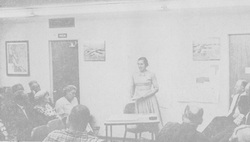
Mrs. Marion Lee, a California City resident, addresses one of the first meetings of the California City Community Club. The first slate of officers of the club were Nick Nevel (President); Cal Caldwell (1st Vice President); Art Watson (2nd Vice President); James Woodrum (Treasurer); and Lida B. Briggs (Secretary).
The California City Community Club was formed in 1959 out of a need for direction and positive action on the part of twenty California City pioneers. Finding themselves in the midst of a new community, bursting with potential and energy, these twenty set about to develop and organize projects and people to assist the community in the most positive directions possible, forseeing future needs and services which would be required as the City grew.
The City needed a community building, where people could meet and discuss their needs for recreation, community projects, local government planning and all other needs of a new community. The Community Club said "can-do" and in November 1960, the first Town Hall building was dedicated, housing the library and later, the volunteer fire department. The City needed a volunteer fire department to protect the residents and homes in the community. Again, the Community Club put their organizing and promoting talents together. In late 1959 and early 1960, the necessary volunteer firefighter organization was formed. Later, when the Kern County Fire Department was contracted for the community, and the new Fire Station was built, the main work force of the Department, was that group of volunteers.
The City needed trees for shade and beautification, and the Community Club said "can-do" once more. They proceeded to develop the tree-planting program wherein 10,000 trees were planted in the City. The City grew, the population grew, and with this growth came the need for self-government. The Community Club established the California City Chamber of Commerce to promote the idea of City incorporation throughout the business community and the resident population as well. The Community Club organized information seminars and meetings to inform the populace of the benefits of self-government. They actively campaigned for the incorporation drive, obtaining signatures on petitions, carrying petitions and representatives to the other governmental levels necessary to work the incorporation miracle. When the voteof the residents came back to incorporate the City, the Community Club set about to introduce and promote the election that won California City its first City Government officials.
Once the dust had settled, the California City Community Club looked around to see what else was needed in the community. Service Clubs were formed with Community Club backing. Organizations such as the Boys Scouts of America and Girl Scouts were looking for sponsorship and the Community Club came through. Support of youth groups continue today as well as feeding the hungry programs.
The California City Community Club was formed in 1959 out of a need for direction and positive action on the part of twenty California City pioneers. Finding themselves in the midst of a new community, bursting with potential and energy, these twenty set about to develop and organize projects and people to assist the community in the most positive directions possible, forseeing future needs and services which would be required as the City grew.
The City needed a community building, where people could meet and discuss their needs for recreation, community projects, local government planning and all other needs of a new community. The Community Club said "can-do" and in November 1960, the first Town Hall building was dedicated, housing the library and later, the volunteer fire department. The City needed a volunteer fire department to protect the residents and homes in the community. Again, the Community Club put their organizing and promoting talents together. In late 1959 and early 1960, the necessary volunteer firefighter organization was formed. Later, when the Kern County Fire Department was contracted for the community, and the new Fire Station was built, the main work force of the Department, was that group of volunteers.
The City needed trees for shade and beautification, and the Community Club said "can-do" once more. They proceeded to develop the tree-planting program wherein 10,000 trees were planted in the City. The City grew, the population grew, and with this growth came the need for self-government. The Community Club established the California City Chamber of Commerce to promote the idea of City incorporation throughout the business community and the resident population as well. The Community Club organized information seminars and meetings to inform the populace of the benefits of self-government. They actively campaigned for the incorporation drive, obtaining signatures on petitions, carrying petitions and representatives to the other governmental levels necessary to work the incorporation miracle. When the voteof the residents came back to incorporate the City, the Community Club set about to introduce and promote the election that won California City its first City Government officials.
Once the dust had settled, the California City Community Club looked around to see what else was needed in the community. Service Clubs were formed with Community Club backing. Organizations such as the Boys Scouts of America and Girl Scouts were looking for sponsorship and the Community Club came through. Support of youth groups continue today as well as feeding the hungry programs.
Scouting
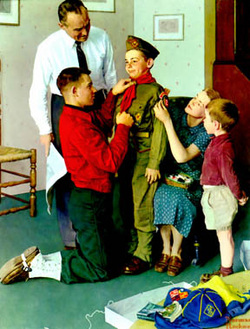
California City Cub Scouts History by Jeff Williams
The California City Cub Scout program began in February 1960 when the California City Community Club decided to sponsor the program. Robert Snedden served as the California City Community Club’s first sponsoring organization representative. The original Pack committee members included Lloyd Caldwell, Muril Bickell, Committee Chair Blaine Edelfsen, Cubmaster Murvin Bickell, and Assistant Cubmaster Roy Nelson. The Pack’s first Den Mother was Mary Lynch. At one time, there were enough Cub Scouts in California City to justify two Cub Scout Packs, Pack 413 and Pack 414. The Pack belongs to the Desert District of the Southern Sierra Council, based in Bakersfield, California.
Since February 1960, 365 adults have volunteered their time to sustain the local Cub Scout program. This includes 30 different Committee Chairs and 20 different Cubmasters. The average Committee Chair has served for 21 months and the average Cubmaster has served for 31 months. The longest serving Committee Chair was Frank Lane with a cumulative total of 7.5 years of service. The longest serving Cubmaster was Jeff Williams with a cumulative total of 10.5 years of service, part of that time serving as Cubmaster for both Packs simultaneously.
Pack 413’s first Cub Scout was George A. Lynch, who was also the first California City Cub Scout to earn a Cub Scout award. Later that year, Wayne Bickell, Terry Edelfsen, Paul O’Connell, Victor Stewart, and Scott Lynch joined Pack 413. Since the inception of the California City Cub Scout program in 1960, 932 Cub Scouts have participated in the local program. The Sprague family holds the distinction of having three generations involved with the organization. Jay Sprague served as Cubmaster from 1968 to 1969. Jay’s son Shawn was a Cub Scout and served as a Den Leader. Shawn’s sons, Daltton and Hyatt, were Cub Scouts in the program.
The California City Cub Scout program began in February 1960 when the California City Community Club decided to sponsor the program. Robert Snedden served as the California City Community Club’s first sponsoring organization representative. The original Pack committee members included Lloyd Caldwell, Muril Bickell, Committee Chair Blaine Edelfsen, Cubmaster Murvin Bickell, and Assistant Cubmaster Roy Nelson. The Pack’s first Den Mother was Mary Lynch. At one time, there were enough Cub Scouts in California City to justify two Cub Scout Packs, Pack 413 and Pack 414. The Pack belongs to the Desert District of the Southern Sierra Council, based in Bakersfield, California.
Since February 1960, 365 adults have volunteered their time to sustain the local Cub Scout program. This includes 30 different Committee Chairs and 20 different Cubmasters. The average Committee Chair has served for 21 months and the average Cubmaster has served for 31 months. The longest serving Committee Chair was Frank Lane with a cumulative total of 7.5 years of service. The longest serving Cubmaster was Jeff Williams with a cumulative total of 10.5 years of service, part of that time serving as Cubmaster for both Packs simultaneously.
Pack 413’s first Cub Scout was George A. Lynch, who was also the first California City Cub Scout to earn a Cub Scout award. Later that year, Wayne Bickell, Terry Edelfsen, Paul O’Connell, Victor Stewart, and Scott Lynch joined Pack 413. Since the inception of the California City Cub Scout program in 1960, 932 Cub Scouts have participated in the local program. The Sprague family holds the distinction of having three generations involved with the organization. Jay Sprague served as Cubmaster from 1968 to 1969. Jay’s son Shawn was a Cub Scout and served as a Den Leader. Shawn’s sons, Daltton and Hyatt, were Cub Scouts in the program.
Parks & Recreation
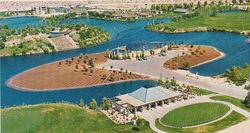
California City is a mecca for recreation, accomplished by a host of activities within Central Park and throughout the surrounding desert areas that provides ideal composites for off-road riding and camping. Lending to the Parks and Rec's secret to success, has been its leadership. Over the years, numerous individuals were responsible for providing California City's citizens a super value in recreation:
1967-68: Roy Savage (Director); 1969-70: Don Lohr (Director); 1971-72: Rich Adams (General Mgr); 1973-75: John Lasagna (Director); 1976-80: Dee McNulty (Rec Supervisor); 1981-82: Don Luther (Director); 1983-88: Dee McNulty (Rec Supervisor); 1989-91: Deanna McNulty (Director); 1992-94: Deanna Sutherland (Director); July 1994: Directors position eliminated.
Since 1976, the Parks Department has received funding through numerous grant sources that provided additions from playground equipment, handball court, bicycle lanes, picnic pavillions, park restrooms, various recreational equipment and a new Senior Center.
1967-68: Roy Savage (Director); 1969-70: Don Lohr (Director); 1971-72: Rich Adams (General Mgr); 1973-75: John Lasagna (Director); 1976-80: Dee McNulty (Rec Supervisor); 1981-82: Don Luther (Director); 1983-88: Dee McNulty (Rec Supervisor); 1989-91: Deanna McNulty (Director); 1992-94: Deanna Sutherland (Director); July 1994: Directors position eliminated.
Since 1976, the Parks Department has received funding through numerous grant sources that provided additions from playground equipment, handball court, bicycle lanes, picnic pavillions, park restrooms, various recreational equipment and a new Senior Center.
Edwards Air Force Base
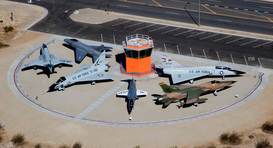
The history of Edwards AFB and the military's use of Rogers and Rosamond lakebeds goes back to the early 1930s when Army Air Corps aircraft from what is now March Air Force Base, Riverside, Calif., flew over the lakebeds for bombing and gunnery practice. During World War II, facilities were established adjacent to Rogers Dry Lake then called Muroc Dry Lake to train bomber and fighter crews for duty overseas.
A water stop for the Soutern Pacific Railroad since 1876, the site was largely unsettled until the early 20th century. In 1910, Ralph, Clifford and Effie Corum built a homestead on the edge of Rogers Lake. The Corums were instrumental in attracting other settlers and building infrastructure in the area. A post office was commissioned for the area, they named it MUROC, a reversal of the Corum name, because there was already a town named Corum.
In 1933, then Colonel Hap Arnold, who later became General of the Air Force, visted MUROC and the surrounding area. He was then the commander of March Field and needed a bombing range. He had heard of Rogers Dry Lake and decided to investigate. He wore civilian clothes because he knew if word got out the military was interested, the price of the land would rise dramatically. As it turned out, the government already owned a large part of the desired area.
Muroc ArmyAir Field started as a tent and shack encampment on the lake shore near Muroc itself. When there was to be bombing practice, refueling and maintenance personnel came with tents from March Field in order to prepare for servicing the planes, which arrived later and landed right on the lake bed. With America's entry into World War II, the importance of Muroc was realized for the first time. The Army Corps of Engineers expanded the bombing and gunnery range and built a replica of a Japanese heavy cruiser for a target, which they named, the "Muroc Maru".
A water stop for the Soutern Pacific Railroad since 1876, the site was largely unsettled until the early 20th century. In 1910, Ralph, Clifford and Effie Corum built a homestead on the edge of Rogers Lake. The Corums were instrumental in attracting other settlers and building infrastructure in the area. A post office was commissioned for the area, they named it MUROC, a reversal of the Corum name, because there was already a town named Corum.
In 1933, then Colonel Hap Arnold, who later became General of the Air Force, visted MUROC and the surrounding area. He was then the commander of March Field and needed a bombing range. He had heard of Rogers Dry Lake and decided to investigate. He wore civilian clothes because he knew if word got out the military was interested, the price of the land would rise dramatically. As it turned out, the government already owned a large part of the desired area.
Muroc ArmyAir Field started as a tent and shack encampment on the lake shore near Muroc itself. When there was to be bombing practice, refueling and maintenance personnel came with tents from March Field in order to prepare for servicing the planes, which arrived later and landed right on the lake bed. With America's entry into World War II, the importance of Muroc was realized for the first time. The Army Corps of Engineers expanded the bombing and gunnery range and built a replica of a Japanese heavy cruiser for a target, which they named, the "Muroc Maru".
Muroc Maru
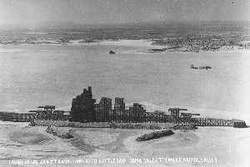
The "Muroc Maru":
A wooden mock-up of a Japanese Cruiser during WWII. Located on the southwest of Rogers Dry Lake, it was used as a recognition device, as well as a target for B-25 Mitchell bombers. It was originally flocked with chopped chicken feathers, which didn't last long in the searing Mojave heat and winds. Dismantled in the 1950s, barely a trace remains today.
During the postwar years, all of America's first generation of jets -- both Air Force and Navy -- underwent testing at Muroc, and the great lakebed served as a welcome haven to countless pilots in distress. In December 1949, Muroc was renamed Edwards Air Force Base in honor of Capt. Glen W. Edwards, who was killed a year earlier in the crash of the YB-49 Flying Wing.
By that time, the base had already become the reigning center of American flight research and on June 25, 1951, this fact was officially recognized with Edwards designated the U.S. Air Force Flight Test Center. Brig. General Al Boyd, considered the father of modern Air Force flight testing, was the first Air Force Flight Test Center commander. The General was quoted as saying about Edwards: "Our most valuable piece of real estate and God's gift to the Air Force".
A wooden mock-up of a Japanese Cruiser during WWII. Located on the southwest of Rogers Dry Lake, it was used as a recognition device, as well as a target for B-25 Mitchell bombers. It was originally flocked with chopped chicken feathers, which didn't last long in the searing Mojave heat and winds. Dismantled in the 1950s, barely a trace remains today.
During the postwar years, all of America's first generation of jets -- both Air Force and Navy -- underwent testing at Muroc, and the great lakebed served as a welcome haven to countless pilots in distress. In December 1949, Muroc was renamed Edwards Air Force Base in honor of Capt. Glen W. Edwards, who was killed a year earlier in the crash of the YB-49 Flying Wing.
By that time, the base had already become the reigning center of American flight research and on June 25, 1951, this fact was officially recognized with Edwards designated the U.S. Air Force Flight Test Center. Brig. General Al Boyd, considered the father of modern Air Force flight testing, was the first Air Force Flight Test Center commander. The General was quoted as saying about Edwards: "Our most valuable piece of real estate and God's gift to the Air Force".
California City Police Department
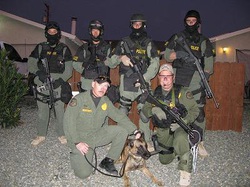
This is a brief history of the California City Police Department from its conception to present day. It covers the Chiefs and leaders only, not the men and women, sworn and non-sworn who served in its ranks and are still serving, making our Community a safer place to live. God Bless each of you.
William H. Dempsey
Chief of Police (Retired)
Chief Leslie Howard 1969-1972
The California City Police Department began operations September 1, 1969. Chief Leslie Howard was sworn in on that date and set up police operations inside a residence at 7827 Randsburg-Mojave Road, now known as California City Boulevard.
The City Council purchased three patrol vehicles and two-way radios. On November 10, 1969 the Department began providing actual police services, with a staff that included, Chief Howard, a sergeant, and three patrolmen. The first call received by the new formed Department was a homicide (187 P.C.) a male juvenile shooting his father.
California City Police Department is the only Police Department in what is known as the Antelope Valley and remains the only Police Department in the Valley. Towards the end of 1969 the Department moved to the newly constructed Fire Station on Hacienda Boulevard. Staffing was now at full strength with the addition of three more police officers.
Chief Howard and the Police Department moved to their third building in January of 1971, a residential dwelling located at 9013 California City Boulevard. By February 1972 the Police Department reached its first of many milestones, when the Reserve Police Unit was formed. Seven volunteers were trained and appointed as reserve officers.
Chief George Howes 1972-1976
In the summer of 1972 the Police Department was on the move again to a new Police Station in the Community Services Building in the Aspen Mall at the corner of 82nd Street and California City Boulevard. Chief Howard bid farewell to the City and the Department Administrative Sergeant was promoted to replace him.
George Howes was sworn in as Chief of Police, September 1972. Originally from Bell Gardens Police Department, Chief Howes served until the latter part of 1976, when he was appointed City Manager.
Department of Public Safety 1976-1979
In 1976 the California City Police Department was combined with the California City Fire Department, forming the Department of Public Safety. This move by the City Council was an attempt to consolidate City operations and save money. Fire Chief Robert Finklea was appointed Head of the Public Safety Department.
Destined for failure from the beginning, the Department of Public Safety never got on track, nor achieved the Community’s expectation of quality service. Attempts at cross-training Police Officers into Firemen and Firemen into Police Officers didn’t achieve the desired results and was not cost efficient, and created problems which could not be overcome.
The City Council split the two services as the seventies was nearing an end, however remnants of the Public Safety concept remained as the City fathers hired a City Manager as head of both Departments, creating even more problems. Failing again to achieve the desired results, the City Council hired a Police Chief and a Fire Chief. Art Thomas, a retired Police Captain from Compton Police Department was hired as Interim Chief in 1979.
Chief Guy Floyd 1979-1983
As the 1980s grew closer Guy Floyd was appointed Chief after transferring from Orange Cove Police Department. Chief Floyd remained at the helm until his retirement in 1983.
Chief William Dempsey 1983-1990
In 1983, the City Council for the second time hired a Chief from within the Department, a long time employee and career Police Officer assumed his duties by the name of William Dempsey, a graduate of the Los Angeles Sheriff’s Academy and the FBI National Academy. He served as Chief for seven years, after retiring, he became City Councilmember serving for twelve years.
Chief Paul Ingram 1991-1993
A newcomer to the scene became the next Chief in 1991, Paul Ingram who came from Williams Police Department, was sworn in as Chief and served the City for the next two years. After his tenure, he was elected to the City Council serving a four year term.
Chief Willie Brown 1993-1997
Willie Brown was appointed interim Chief in August 1993 and was sworn in as Chief of Police in March of 1994. Chief Brown herald from Soledad Police Department. Leaving the Police Department in 1997, he became a private investigator. It was during his tenure that the Police Department moved to a new facility located near City Hall on Hacienda Boulevard.
The Police Department was managed by the Office of the City Manager following Chief Brown's departure.
Chief L. Wayne Dickerson 1999-2004
The next Chief was chosen from within the Department, L. Wayne Dickerson, who was hired as a Police Officer in 1977. Promoted to Lieutenant in 1982, he became Chief of Police, and also served on the School Board for the Mojave Unified School District, retiring on November 1, 2004.
On December 9, 2000, the new Police Facility was dedicated as the William H. Dempsey Police Facility.
Chief Linda Lunsford 2004-2008
Linda Lunsford, another long time employee of the Department became Chief of Police, November 1, 2004. She began as a Reserve Police Officer in September 1976, later becoming a regular Police Officer in August 1977, rising through the ranks to Lieutenant before her promotion to Chief. She was the first female to serve as Chief of Police in California City as well as all of Kern County’s Police Departments. Upon the unexpected departure of the City Manager in December of 2007, the City Council elevated Linda to the position. She appointed the Department’s Lieutenant as Acting Chief in January 2008. Linda retired from public service in January of 2010.
Chief Steve W. Colerick 2008-2011
On February 18, 2008, the City Council appointed Steve Colerick as Chief of Police. Steve began his career as a Reserve Police Officer for the California City Police Department from 1980 to 1983, after serving a tour in the United States Air Force. He then became a Deputy Sheriff for the County of Ventura, California, serving from 1983 to 1988, returning to the California City Police Department as a Police Officer. He was promoted to Sergeant in 1993 and later Lieutenant, in 1999. During his leadership, he developed the SWAT Certified Special Enforcement Team and State recognized Desert Incident Response Team, a full service Search and Rescue unit. He aligned the Department’s Policies and Procedures and Field Training to State Standards and established a full-time detective unit, while elevating Department staffing to 17 police officers. After 35 years in government service, Steve retired on January 22, 2011, to be with his long time best friend and wife Alice.
(Editor’s Note): In January of 2011, the City Council appointed from within the Department, Lieutenant Eric Hurtado, to Chief of Police.
William H. Dempsey
Chief of Police (Retired)
Chief Leslie Howard 1969-1972
The California City Police Department began operations September 1, 1969. Chief Leslie Howard was sworn in on that date and set up police operations inside a residence at 7827 Randsburg-Mojave Road, now known as California City Boulevard.
The City Council purchased three patrol vehicles and two-way radios. On November 10, 1969 the Department began providing actual police services, with a staff that included, Chief Howard, a sergeant, and three patrolmen. The first call received by the new formed Department was a homicide (187 P.C.) a male juvenile shooting his father.
California City Police Department is the only Police Department in what is known as the Antelope Valley and remains the only Police Department in the Valley. Towards the end of 1969 the Department moved to the newly constructed Fire Station on Hacienda Boulevard. Staffing was now at full strength with the addition of three more police officers.
Chief Howard and the Police Department moved to their third building in January of 1971, a residential dwelling located at 9013 California City Boulevard. By February 1972 the Police Department reached its first of many milestones, when the Reserve Police Unit was formed. Seven volunteers were trained and appointed as reserve officers.
Chief George Howes 1972-1976
In the summer of 1972 the Police Department was on the move again to a new Police Station in the Community Services Building in the Aspen Mall at the corner of 82nd Street and California City Boulevard. Chief Howard bid farewell to the City and the Department Administrative Sergeant was promoted to replace him.
George Howes was sworn in as Chief of Police, September 1972. Originally from Bell Gardens Police Department, Chief Howes served until the latter part of 1976, when he was appointed City Manager.
Department of Public Safety 1976-1979
In 1976 the California City Police Department was combined with the California City Fire Department, forming the Department of Public Safety. This move by the City Council was an attempt to consolidate City operations and save money. Fire Chief Robert Finklea was appointed Head of the Public Safety Department.
Destined for failure from the beginning, the Department of Public Safety never got on track, nor achieved the Community’s expectation of quality service. Attempts at cross-training Police Officers into Firemen and Firemen into Police Officers didn’t achieve the desired results and was not cost efficient, and created problems which could not be overcome.
The City Council split the two services as the seventies was nearing an end, however remnants of the Public Safety concept remained as the City fathers hired a City Manager as head of both Departments, creating even more problems. Failing again to achieve the desired results, the City Council hired a Police Chief and a Fire Chief. Art Thomas, a retired Police Captain from Compton Police Department was hired as Interim Chief in 1979.
Chief Guy Floyd 1979-1983
As the 1980s grew closer Guy Floyd was appointed Chief after transferring from Orange Cove Police Department. Chief Floyd remained at the helm until his retirement in 1983.
Chief William Dempsey 1983-1990
In 1983, the City Council for the second time hired a Chief from within the Department, a long time employee and career Police Officer assumed his duties by the name of William Dempsey, a graduate of the Los Angeles Sheriff’s Academy and the FBI National Academy. He served as Chief for seven years, after retiring, he became City Councilmember serving for twelve years.
Chief Paul Ingram 1991-1993
A newcomer to the scene became the next Chief in 1991, Paul Ingram who came from Williams Police Department, was sworn in as Chief and served the City for the next two years. After his tenure, he was elected to the City Council serving a four year term.
Chief Willie Brown 1993-1997
Willie Brown was appointed interim Chief in August 1993 and was sworn in as Chief of Police in March of 1994. Chief Brown herald from Soledad Police Department. Leaving the Police Department in 1997, he became a private investigator. It was during his tenure that the Police Department moved to a new facility located near City Hall on Hacienda Boulevard.
The Police Department was managed by the Office of the City Manager following Chief Brown's departure.
Chief L. Wayne Dickerson 1999-2004
The next Chief was chosen from within the Department, L. Wayne Dickerson, who was hired as a Police Officer in 1977. Promoted to Lieutenant in 1982, he became Chief of Police, and also served on the School Board for the Mojave Unified School District, retiring on November 1, 2004.
On December 9, 2000, the new Police Facility was dedicated as the William H. Dempsey Police Facility.
Chief Linda Lunsford 2004-2008
Linda Lunsford, another long time employee of the Department became Chief of Police, November 1, 2004. She began as a Reserve Police Officer in September 1976, later becoming a regular Police Officer in August 1977, rising through the ranks to Lieutenant before her promotion to Chief. She was the first female to serve as Chief of Police in California City as well as all of Kern County’s Police Departments. Upon the unexpected departure of the City Manager in December of 2007, the City Council elevated Linda to the position. She appointed the Department’s Lieutenant as Acting Chief in January 2008. Linda retired from public service in January of 2010.
Chief Steve W. Colerick 2008-2011
On February 18, 2008, the City Council appointed Steve Colerick as Chief of Police. Steve began his career as a Reserve Police Officer for the California City Police Department from 1980 to 1983, after serving a tour in the United States Air Force. He then became a Deputy Sheriff for the County of Ventura, California, serving from 1983 to 1988, returning to the California City Police Department as a Police Officer. He was promoted to Sergeant in 1993 and later Lieutenant, in 1999. During his leadership, he developed the SWAT Certified Special Enforcement Team and State recognized Desert Incident Response Team, a full service Search and Rescue unit. He aligned the Department’s Policies and Procedures and Field Training to State Standards and established a full-time detective unit, while elevating Department staffing to 17 police officers. After 35 years in government service, Steve retired on January 22, 2011, to be with his long time best friend and wife Alice.
(Editor’s Note): In January of 2011, the City Council appointed from within the Department, Lieutenant Eric Hurtado, to Chief of Police.
